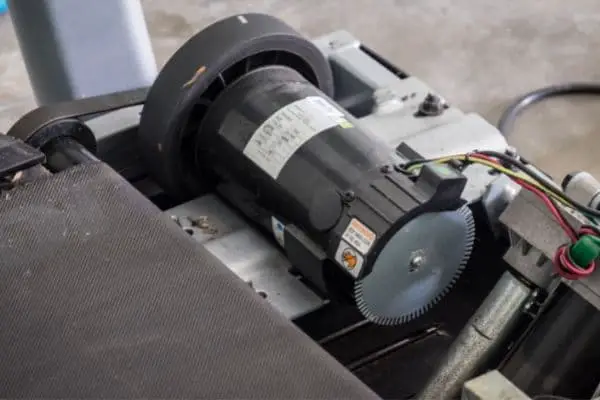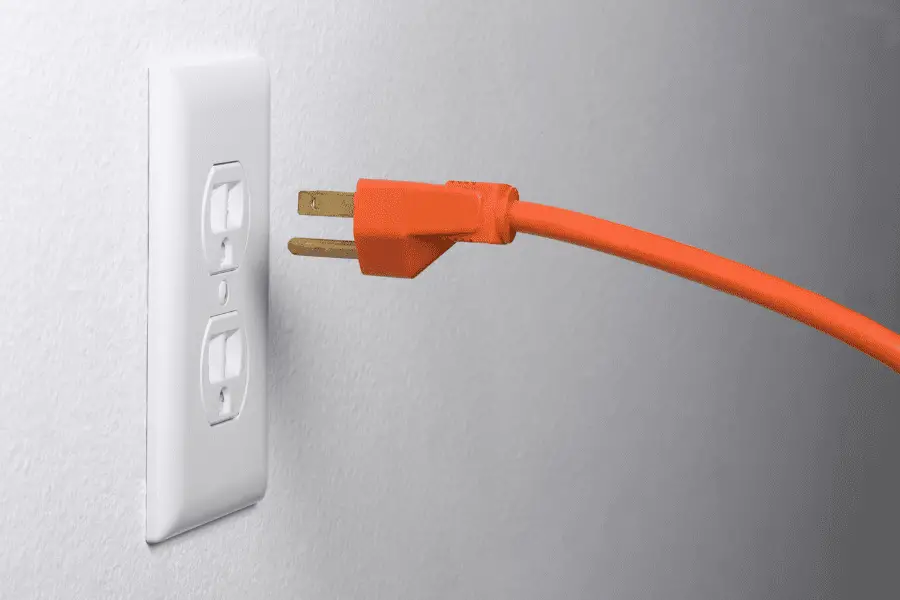Treadmills are made to sweat on but they are also full of electrical components. Getting those wet seems like a bad idea but does that mean you have to carefully catch every drop of sweat you worked so hard for?
Spilling sweat, small amounts of water, or cleaning a treadmill with a damp cloth isn’t a problem. However, since it contains electronic components, allowing a treadmill to get soaked can lead to malfunctions and permanent damage. Owners should always clean and dry spills immediately after they occur to avoid irreparable damages.
Read on for an in-depth guide on using and maintaining treadmills, and what to do if yours accidentally gets wet.
Contents
What Happens When a Treadmill Gets Wet?
Spilling some sweat or a bit of water on your treadmill isn’t going to do any damage. Dumping a gallon of water on the console or letting it stand outside in the rain is going to cause the treadmill to stop working very quickly.
When you spill a significant amount of water on your treadmill, try to clean it up as quickly as possible with some absorbent towels or cloths.
If too much water gets into the treadmill it can cause a few issues:
Can You Use Water To Clean a Treadmill?
You might wonder if using water to clean a treadmill is a good idea. Again it really depends on the amount of water you plan to use.
To clean a treadmill, a damp cloth is the best option. This effectively gets rid of any dust, dirt, and sweat but won’t get the machine wet enough to cause any problems. Be careful with the console. Simple consoles can handle quite a bit but modern touchscreen ones do need some more care. Just clean those like you would a laptop.
Cleaning the belt can be done by turning the treadmill on, and holding a damp cloth in one spot of the belt until it made one revolution. Then clean the next spot. Then let the treadmill run until the belt is dry again. Don’t stop the treadmill with a damp belt. The moisture can collect around the motor and cause problems.
How Wet Can a Treadmill Get?
Allowing a treadmill to get extra wet is not advisable. Though its electronic components are shielded by the belt and covers, they can still get damaged when water enters the internal system. While treadmills are designed to handle sweat, exposure to rain, high humidity, or spills could cause serious problems.
Below is a brief discussion of different types of wetness and how to handle them when they occur.
Sweat

Sweating is a normal part of exercising. Since treadmills are primarily meant for cardio exercises, they’re usually designed to take in a lot of sweat without getting damaged. This is because sweating is inevitable when running or walking on a treadmill and is factored in at the time of manufacturing.
So, can excess sweat damage a treadmill? Fortunately, treadmills come with strategic designs that often shield or protect the internal components. This helps ensure that sweat doesn’t reach the highly sensitive electric parts. However, it is still advisable to dress light when exercising on a treadmill to avoid soaking the device with sweat.
If you’re a heavy sweater, keep a little towel nearby so you can wipe down any excess liquids.
Click here to read more about protecting your treadmill’s electronics.
Rain
As a rule, treadmills should never be kept outside and exposed to dust and rain. While some might insist on placing covers over treadmills in outdoor locations, the risk is too much and will most likely leave owners counting losses.
Allowing a treadmill to stay out in the rain is a sure recipe for disaster since the devices aren’t designed to take in a high amount of wetness. When moving a treadmill to a different location, it’s best to transport it when fully sealed as a safety measure in case of rain. Either way, you should try as much as possible to keep your treadmill away from the rain.
Looking for a good spot to put your treadmill? Click here for a breakdown of the best places.
Humidity
Using a treadmill in a humid environment won’t damage the device. However, it can reduce the treadmill’s lifespan, especially if placed in a highly humid location. The trick to prolonging a treadmill’s durability is by drying it up frequently. This will help prevent condensed droplets from seeping through the belt and into the sensitive areas.
Suggested: Can you keep an elliptical trainer in the garage?
Spills
It’s practically impossible to use a treadmill without spilling water (or a cooling drink) at some point. And although treadmills are designed to handle sweat and occasional spills, excessive spillage can lead to serious problems.
Spilling negligible amounts of fluids won’t do much harm to your treadmill. However, the problem comes in when you spill a large amount of water when cleaning either the treadmill or other equipment in your home gym.
As a good rule of thumb, you should always wipe spills immediately when they occur. Allowing a spill to soak isn’t recommended as the droplets might end up inside the belt and damage the motors and other electrical parts.
You should also remove any standing water to eliminate the risk of droplets entering the sensitive parts of the treadmill. Put simply, you shouldn’t allow any water to sit next to the treadmill.
Suggested: 12 tips for buying a second-hand treadmill
What Problems Can Occur When Treadmills Get Wet?
Although a treadmill might not get damaged immediately when it’s exposed to excess water and moisture, it may wear out at a faster rate than normal. Dry rot, motor damage, reduced or inconsistent performance, and a voided warranty are a few of the possible consequences of getting your treadmill wet.
Let’s break down some of the problems that can occur when treadmills get wet.
Dry Rot
Water exposure can lead to dry rot on the walking belt, consequently damaging the belt. A belt with dry rot will not move as expected due to a high friction load, which will gradually reduce the treadmill’s performance. The rear and front rollers will have to work harder for the machine to keep moving, which also leads to premature wear and tear.
Suggested: How much does a treadmill belt replacement cost?
Motor Damage

The more the friction load increases, the more the motors will have to work to manage the load and keep the belt moving. This also has a negative effect on the motor control board as more power will be needed to run the entire system. The increased power needs will lead to heat buildup on the board, thereby increasing the chances of damaging other components like the circuit breaker and power switch.
Suggested: How much does a treadmill motor replacement cost?
Reduced Performance
While a treadmill can survive light spills and high humid levels, excessive exposure to water will gradually lead to reduced performance. The motors and rollers will have to do more work to keep the belt moving, leading to significantly reduced performance levels. Failure to replace the damaged parts means that other parts will be overworked and start to wear and tear at faster than normal rates.
Null Warranty
Most high-quality treadmills come with friendly warranties that justify the often high initial cost of investment. For instance, the NordicTrack T Series Treadmill from Amazon.com comes with a 10-year frame warranty, one-year labor warranty, and two years parts warranty.
Suggested: Treadmill warranties. Which is best?
However, for the warranty to remain valid, owners must not subject the treadmill to poor treatment. Incidents like exposure to water or chemical spills will make a warranty null and void, meaning you’ll need to dig deep in your pocket to make repairs and replacements.
Inconsistent Performance
If you notice that a treadmill is no longer responding to keyed-in instructions, then chances are some internal components were exposed to water. The problem usually gets worse with time, which can even lead to the malfunction of the touchscreen. As a result, you should consult an expert once you notice that your treadmill isn’t working as expected.
What To Do When a Treadmill Gets Wet
Treadmills are bound to get wet every now and then since, after all, they’re usually kept in areas that need regular cleaning.
Here’s what to do when a treadmill gets wet:
- Unplug the treadmill.
- Wipe out the spill.
- Examine the internal parts.
- Allow the treadmill enough time to dry.
1. Unplug the Treadmill.
If you happen to spill something on the treadmill or accidentally spill water on the floor, the first step to take should be turning the device off. Turning it off will prevent the belt from moving the moisture or droplets to the inner parts of the device.

2. Wipe Out the Spill.
Once you’ve turned off the treadmill, the next step to take should be drying out the fluids or water on the surface of the device. The faster you dry out the water, the higher your chances of saving the treadmill from damage.
It is advisable to use a dry towel to soak up the water. Use as many towels or dry clothes as possible until you have dried the treadmill completely. Making sure the space is well ventilated also helps dry everything quicker.
3. Examine the Internal Parts.
This step should apply if you’re knowledgeable about treadmills. However, if you’re relatively green about how treadmills work, then it’s best to reach out to an expert. Point to note, though, you shouldn’t open the treadmill if you dried out the spill before it penetrated the seams.
But if you’re certain the water, chemical, or drink made its way inside the treadmill, then it’s best to open it carefully to examine the inner parts. Take out the user’s manual and use a screwdriver to loosen the screws. Examine the motors to see if they’re compromised. Some motors might need to be dried up before being placed back, while in some cases, you might need to change the motors altogether.
Pro tip: Opening the treadmill might lead to a voided warranty. Therefore, consult with your manual to learn the terms and conditions before proceeding.
4. Allow the Treadmill Enough Time To Dry.
While it might be tempting to plug the treadmill in to see if it’s working after a spill, allowing it enough time to dry internally is highly recommended. For minor spills that you managed to dry on time, you won’t need to wait for too long before powering and using the device again.
However, if the treadmill gets alarmingly wet, it’s best to wait for several hours, say over 12 hours, before using it. Giving your treadmill a bit of time to recover will prevent issues such as short circuits.
Wrapping Up
A treadmill is designed to accommodate heavy thuds and steps. And while the device can withstand small amounts of wetness, too much exposure to fluids can ruin the internal electrical components. As a result, it is highly advisable to dry your treadmill whenever spills occur.
You should also take up a habit of cleaning the device whenever you’re done to prevent sweat from gradually corroding the surfaces. Try as much as possible to place your treadmill on a high-quality mat to prevent dirt buildup, trap dust and most importantly, prevent the lower parts from wearing out quickly.
Favorite Cardio Accessories
Check out these accessories that improve a home cardio workout:
- Equipment mat: All cardio equipment should be put on an equipment mat. The Rubber-Cal mat (Amazon) is an affordable yet very high-quality choice.
- Interval timer: To time your intervals and workouts, there is no better choice than the GymNext Flex. It’s super easy to use and set up with a phone app.
- Tablet holder: Cardio can be boring. With this tablet holder (Amazon) you can follow along with on-demand workouts or just watch a movie on any cardio machine.
- Heart rate monitor: Monitoring your heart rate is very important while doing cardio. The Polar H10 (Amazon) connects to almost anything you can imagine and is very accurate.
To find which cardio machines I recommend for home gyms, click here.
Sources
- Treadmill Reviews: Treadmill Care And Maintenance, Making Your Treadmill For The Home Last
- Livefit: The Ultimate Treadmill Buyers Guide
- Consumer Reports: How To Maintain Your Treadmill
- Livefit: The Ultimate Treadmill Buyers Guide
- Treadmill: Can A Treadmill Get Wet
- Hnpfit: Treadmill Maintenance
- Empire Fitness Services: Treadmill In A Flood
- Verywellfit: Easy Home Treadmill Maintenance Tips

